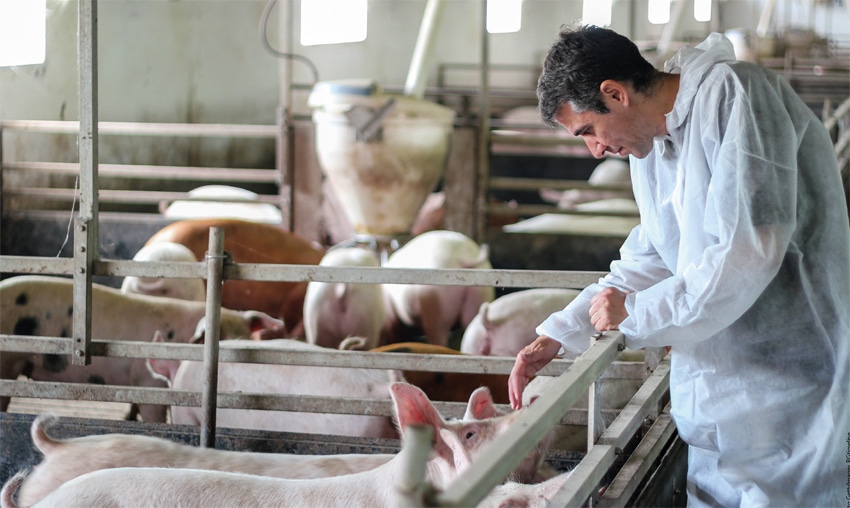By Diego Padoan, Swine Technical Manager at BIOMIN
Prevention is the best medicine. Biosecurity is all about keeping pathogens out of the farm (external biosecurity), and stopping shedding of what is already present inside the farm (internal biosecurity).
Managing health is not necessarily high-tech. Applying common sense and regular routine into working practices on the farm go a long way to ensuring success. Here are four steps to establishing robust biosecurity on your site.
1. Define the farm’s health status
2. Eliminate vertically transmitted diseases
3. Keep out infection
4. Implement a vaccination programme
Getting started
The starting point is to define or establish the health status of the farm, which must be the highest possible in relation to the local environment, epidemiology and proximity of other farms.
Disease pathogens that can be transmitted from the mother, such as Mycoplasma, Porcine reproductive and respiratory syndrome virus (PRRSv) and Actinobacillus Pleuropneumonia (APP), must be eliminated when starting a pig production enterprise. The focus should then move to biosecurity programmes to try to keep out infections that are hard to eliminate. Finally, robust vaccination programmes should be implemented against pathogens that cannot be eliminated: E. coli K88/F18, Lawsonia intracellularis, PCV-2, PRRSV, Streptococcus and Haemophilus.
Unit location
If possible, the farm should be located in a swine-free area, at least six kilometers from any other swine unit. Some pathogens can survive outside the pig for four days (PRRSv) and up to 18 months in the case of African swine fever virus (ASFv). Bacillus anthracis can persist indefinitely in the ground, and some pathogens can travel with dust particles or aerosol droplets, from a few meters (APP, Pasteurella, Mycoplasma hyopneumoniae and M. hyosynoviae, Haemophilus, Streptococcus), to 3 km (SIV, PRCV) or 5 km (PRRSV), and even up to 9 km (Aujeszky’s disease virus, foot and mouth disease virus). Air filtration can be essential in areas with a high density of pigs.
Housing
Animal housing should have good quality flooring and installations, and good environmental conditions (ventilation, temperature). Density levels (m 2 and m 3 allowances) must be respected, and an all-in/all-out system implemented by room, with cleaning and disinfection between batches. Separate accommodation must be provided for sick animals.
Line of separation
All swine farms must have a clear separation from the external environment, known as a line of separation. All persons, animals and objects that have no reason to enter must remain outside (e.g., feed trucks, carcass disposal trucks, pets, birds, vermin and fl ies). Animals, people, feed, water, equipment, air are all vectors that can act as a threat to pig health. Whoever and whatever enters the farm must be closely controlled and properly disinfected, and a logbook must be provided to register whatever and whoever is entering. Anyone entering must change footwear upon entry, and wash and disinfect hands, as these are the most common vehicles of infection. When changing shoes to dedicated footwear, there must be no crossover between the dirty and clean areas. This is why the “Danish entry” is the best system. Visitors sit on a bench and take off their own shoes, then swing their legs over the bench and put on the farm’s own footwear on the other side of the bench.
Where possible, there should be a dedicated changing room where this can be done. The visitor should then shower and dress in garments provided by the farm. All equipment entering the farm should preferably be new and must be thoroughly cleaned and disinfected before entry (UV radiation). Materials must be of a good quality, and easy to clean and maintain.
Internal biosecurity
Internal biosecurity requires dedicated people, equipment (buckets, brushes, shovels etc.) and clothing of different colours for every section: gilts, sows, nurseries and fi nishing. Never cross animal paths or work paths, and always change or clean boots at a boot wash station when exiting the work area and after entering the sick bay.
Disinfection
Disinfectants are to be used only after cleaning, as few have a detergent action (proxygen compounds, iodophors, quaternary ammonium compounds or QAC). There are many categories: chlorine-based, peroxygen, unchlorinated phenol, chlorinated phenol, iodophors and QAC. Priority should be given to the safest, most effective, product. For example, peroxygen compounds can be safely used as aerosols. They are non-corrosive and detergent, and work in the presence of organic matter. They act quickly and effectively against bacteria and viruses, leave no residues, do not stain, are non-toxic or non-irritant and are suitable for footbaths.
Vaccination
Determination of the infection risk according to the epidemiology of the local area will form the basis for a vaccination schedule. Some vaccines are chosen to directly protect the sows and stimulate immunity to protect the piglets through the colostrum (parvovirus, leptospira, erysipelas, Salmonella, Lawsonia intracellularis, Mycoplasma, SIV, PRRSv) and some are provided directly to the piglets (SIV, E. coli, Clostridium perfringens types A and C, PRRSv, rotavirus, Mycoplasma, PCV2, APP etc.). The timing depends on the disappearance of maternal immunity and how early the infection occurs or disease signs appear. As vaccination will never provide 100% protection, biosecurity and good management practice remain essential.
African Swine Fever
Recently, African swine fever (ASF) outbreaks in numerous countries have created serious cause for concern throughout the swine industry. The World Organisation for Animal Health (OIE) has issued an awareness campaign to highlight general precautions that pig producers can take to limit the risk of spreading ASF.
General precautions from OIE for commercial farmers:
• Declare any suspicious case (dead or alive) to the veterinary services.
• Ensure that all workers and visitors are aware of biosecurity rules.
• Clean and disinfect material and equipment coming in or out.
• Prevent direct or indirect contact with wild boar. Implement quarantine measures for new pigs on farm.
• Do not feed untreated swill containing meat to your pigs.
The South African Pork Producers’ Organisation (SAPPO) coordinates industry interventions and collaboratively manages risks in the value chain to enable the sustainability and profitability of pork producers in South Africa.









